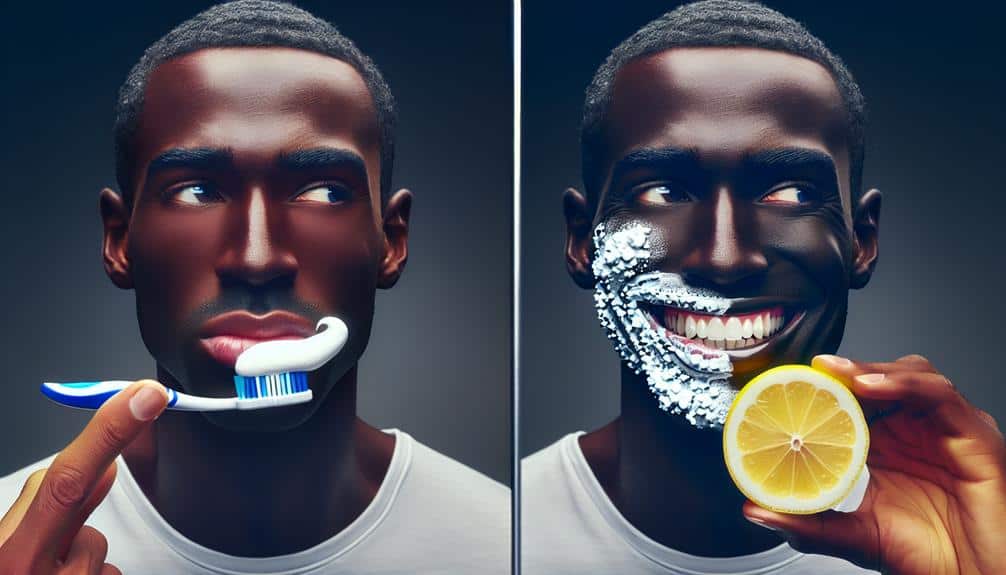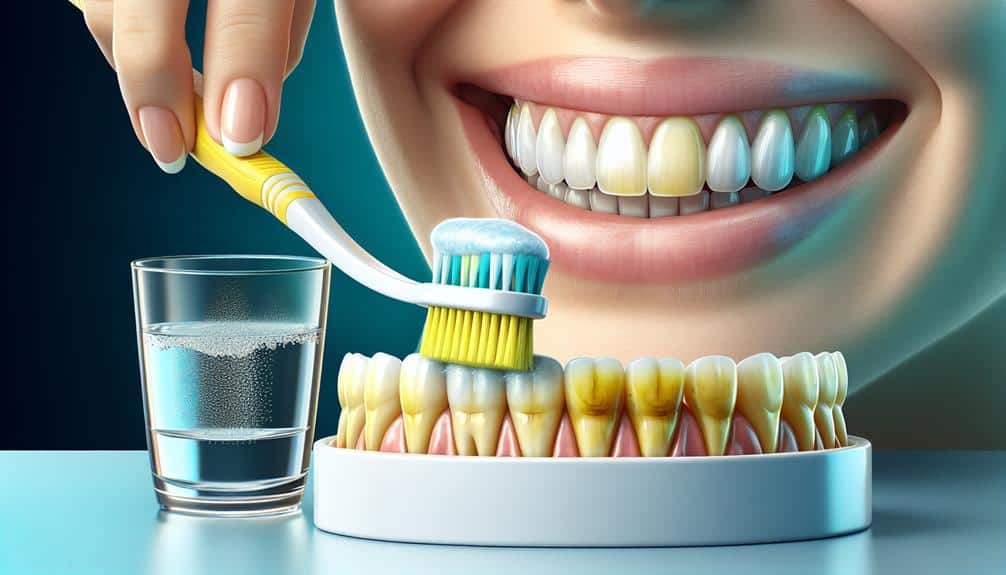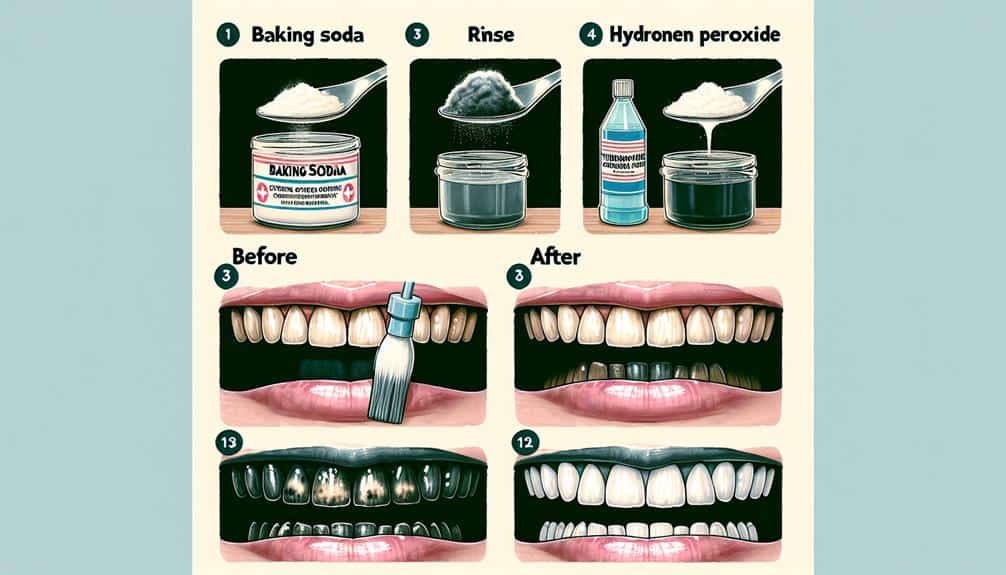To remove tetracycline stains and brighten your smile, consider professional teeth whitening treatments for customized, effective results. Home remedies like baking soda and oil pulling with coconut oil can also help. Over-the-counter whitening products such as gel and strips offer convenient solutions. Maintain a brighter smile by establishing good oral hygiene habits, using whitening toothpaste, and incorporating natural cleaning methods. Achieve a radiant, stain-free smile with these top methods for tackling tetracycline stains.
Key Points
- Professional teeth whitening treatments effectively address tetracycline stains with specialized bleaching agents.
- Consider home remedies like baking soda, oil pulling, and hydrogen peroxide mouthwash for gradual stain reduction.
- Over-the-counter whitening products such as strips, toothpaste, pens, mouthwash, and gels target stains effectively.
- Maintain a brighter smile with a consistent oral hygiene routine, soft-bristled toothbrush, and avoiding stain-causing foods.
- Incorporate crunchy fruits and vegetables for natural cleaning and whitening effects in your diet.
Understanding Tetracycline Stains
To comprehend tetracycline stains, you must first grasp the mechanism by which these discolorations occur on teeth. Tetracycline antibiotics, when taken during tooth development, can bind to calcium ions in the forming teeth, causing intrinsic stains that range from yellow to dark brown or grey. This discoloration happens because tetracycline becomes incorporated into the mineral structure of the teeth, affecting their color permanently. The severity of the staining can vary depending on factors such as the dosage of tetracycline, the duration of use, and the stage of tooth development when the medication was taken.
Prevention of tetracycline stains involves avoiding the use of tetracycline antibiotics during pregnancy and in children under the age of 8 when teeth are still developing. If tetracycline use is necessary, consulting with a healthcare provider to explore alternative medications that don't cause tooth discoloration is advisable. Understanding the causes and taking preventive measures is essential in managing tetracycline stains on teeth.
Professional Teeth Whitening Treatments
Consider seeking professional teeth whitening treatments from experienced dental professionals to effectively address tetracycline stains on your teeth. Dental procedures such as professional teeth whitening can greatly reduce the appearance of tetracycline stains, restoring a brighter smile. Cosmetic dentistry offers various options for teeth whitening, including in-office treatments that provide rapid and noticeable results.
Professional teeth whitening treatments involve the use of specialized bleaching agents that penetrate the enamel to break down stains effectively. Dental professionals have the expertise to customize the treatment to suit your specific needs, ensuring a safe and efficient whitening process. Unlike over-the-counter products, professional whitening treatments offer stronger whitening agents that can tackle stubborn tetracycline stains more effectively.
Home Remedies for Tetracycline Stains
For individuals seeking alternative solutions to tackle tetracycline stains on their teeth, exploring home remedies can be a practical approach. There are several natural solutions and DIY tricks that you can try to help brighten your smile right from the comfort of your own home.
One effective home remedy is baking soda. Its mild abrasiveness can help scrub away surface stains on your teeth. You can make a paste by mixing a small amount of baking soda with water and brushing your teeth with it a few times a week.
Another popular DIY trick is oil pulling. Swishing coconut oil around in your mouth for about 15-20 minutes each day may help reduce bacteria and plaque buildup that could contribute to discoloration.
Additionally, using hydrogen peroxide as a mouthwash (diluted with water) can also aid in whitening teeth. Just be sure not to swallow the mixture.
These natural solutions and DIY tricks can be effective in gradually reducing tetracycline stains and enhancing the brightness of your smile without the need for professional treatments.
Over-the-Counter Whitening Products
When looking to address tetracycline stains on your teeth, exploring over-the-counter whitening products can provide a convenient and accessible option for enhancing the brightness of your smile. Here are some key points to keep in mind:
- Professional-Grade Whitening Strips: These strips contain higher concentrations of whitening agents for effective stain removal.
- Whitening Toothpaste: Specifically formulated to gently polish away stains and brighten your teeth over time.
- Whitening Pens: Perfect for targeting specific areas, these pens are easy to use and can help lighten stains effectively.
- Whitening Mouthwash: Helps maintain a bright smile by reaching areas toothbrushes may miss, fighting stains, and freshening breath.
- Whitening Gels: Applied directly to the teeth, these gels work overnight to break down stains and improve overall whiteness.
Maintenance Tips for Brighter Smile
To maintain a brighter smile, it's essential to establish a consistent oral hygiene routine that includes daily brushing, flossing, and regular dental check-ups. When it comes to brushing techniques, it's important to use a soft-bristled toothbrush and gentle, circular motions to effectively remove plaque and prevent staining. Make sure to brush for at least two minutes, reaching all surfaces of your teeth, including the back molars and along the gumline.
In addition to proper brushing techniques, your dietary habits play a significant role in maintaining a bright smile. Avoid foods and beverages that are known to stain teeth, such as coffee, tea, red wine, and berries. If you do consume these items, consider rinsing your mouth with water afterward or brushing your teeth to minimize their staining effects. Including crunchy fruits and vegetables like apples and carrots in your diet can also help naturally clean and whiten your teeth.
Frequently Asked Questions
Can Tetracycline Stains Be Completely Removed With Any of the Methods Mentioned in the Article?
To completely remove tetracycline stains, methods mentioned in the article have varying effectiveness. However, there are limitations to bear in mind. Consult a dental professional for personalized advice on the most suitable treatment for your specific case.
Are There Any Specific Foods or Drinks That Should Be Avoided to Prevent Tetracycline Stains From Worsening?
You might think avoiding colorful foods or drinks would help, but that's not the case with tetracycline stains. Preventive measures involve limiting highly pigmented items like berries, coffee, and red wine to keep stains from worsening.
How Long Does It Typically Take to See Results From Professional Teeth Whitening Treatments for Tetracycline Stains?
For professional teeth whitening treatments targeting tetracycline stains, results vary. Typically, you may notice improvement within a few sessions. Success rates are high, with treatment duration ranging from one to three weeks. Regular maintenance is key for long-lasting brightness.
Are There Any Potential Side Effects or Risks Associated With Using Over-The-Counter Whitening Products on Tetracycline Stains?
When using over-the-counter whitening products on tetracycline stains, be aware of potential risks. Safety concerns include increased tooth sensitivity, gum irritation, and uneven whitening results. Consult a dentist to discuss the best options for your situation.
Can Tetracycline Stains Come Back After They Have Been Successfully Treated and Removed?
You've conquered those tetracycline stains, but can they sneak back into your smile uninvited? Stay vigilant! Preventing tetracycline stain recurrence involves maintaining good oral hygiene, regular dental check-ups, and possibly touch-up treatments as needed.



